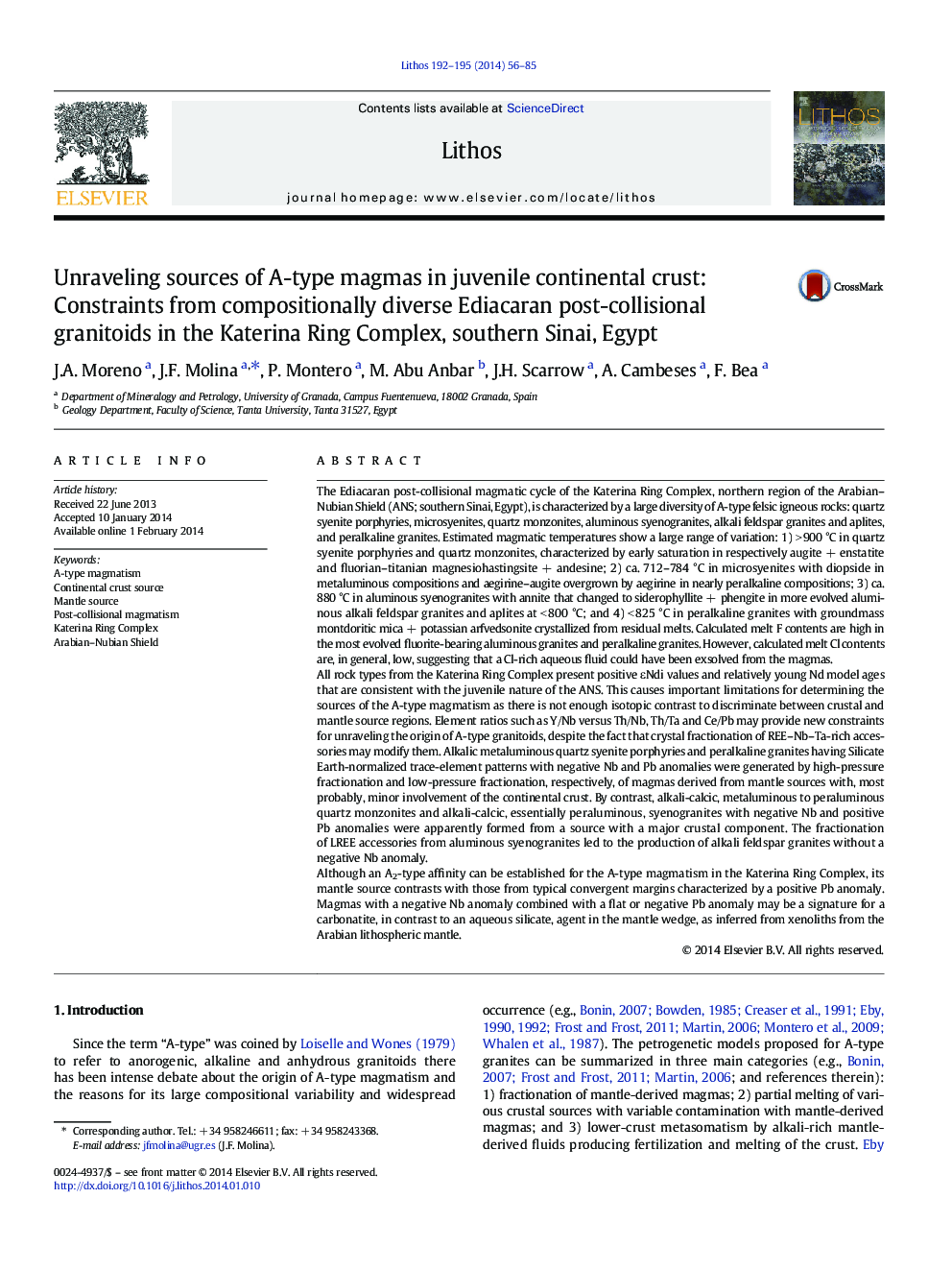| کد مقاله | کد نشریه | سال انتشار | مقاله انگلیسی | نسخه تمام متن |
|---|---|---|---|---|
| 4716042 | 1638679 | 2014 | 30 صفحه PDF | دانلود رایگان |

• The Katerina Ring Complex shows large diversity of coeval A-type granitoids.
• Magma sources for Q-syenite porphyry and peralkaline granite are mantle dominated.
• Magma sources for Q-monzonite and aluminous granite are continental-crust dominated.
• Mantle source chemistry is subduction-related, but influenced by a carbonatitic agent.
• Negative Nb and Pb anomalies in A-type granitoids may reveal a carbonatitic component.
The Ediacaran post-collisional magmatic cycle of the Katerina Ring Complex, northern region of the Arabian–Nubian Shield (ANS; southern Sinai, Egypt), is characterized by a large diversity of A-type felsic igneous rocks: quartz syenite porphyries, microsyenites, quartz monzonites, aluminous syenogranites, alkali feldspar granites and aplites, and peralkaline granites. Estimated magmatic temperatures show a large range of variation: 1) > 900 °C in quartz syenite porphyries and quartz monzonites, characterized by early saturation in respectively augite + enstatite and fluorian–titanian magnesiohastingsite + andesine; 2) ca. 712–784 °C in microsyenites with diopside in metaluminous compositions and aegirine–augite overgrown by aegirine in nearly peralkaline compositions; 3) ca. 880 °C in aluminous syenogranites with annite that changed to siderophyllite + phengite in more evolved aluminous alkali feldspar granites and aplites at < 800 °C; and 4) < 825 °C in peralkaline granites with groundmass montdoritic mica + potassian arfvedsonite crystallized from residual melts. Calculated melt F contents are high in the most evolved fluorite-bearing aluminous granites and peralkaline granites. However, calculated melt Cl contents are, in general, low, suggesting that a Cl-rich aqueous fluid could have been exsolved from the magmas.All rock types from the Katerina Ring Complex present positive εNdi values and relatively young Nd model ages that are consistent with the juvenile nature of the ANS. This causes important limitations for determining the sources of the A-type magmatism as there is not enough isotopic contrast to discriminate between crustal and mantle source regions. Element ratios such as Y/Nb versus Th/Nb, Th/Ta and Ce/Pb may provide new constraints for unraveling the origin of A-type granitoids, despite the fact that crystal fractionation of REE–Nb–Ta-rich accessories may modify them. Alkalic metaluminous quartz syenite porphyries and peralkaline granites having Silicate Earth-normalized trace-element patterns with negative Nb and Pb anomalies were generated by high-pressure fractionation and low-pressure fractionation, respectively, of magmas derived from mantle sources with, most probably, minor involvement of the continental crust. By contrast, alkali-calcic, metaluminous to peraluminous quartz monzonites and alkali-calcic, essentially peraluminous, syenogranites with negative Nb and positive Pb anomalies were apparently formed from a source with a major crustal component. The fractionation of LREE accessories from aluminous syenogranites led to the production of alkali feldspar granites without a negative Nb anomaly.Although an A2-type affinity can be established for the A-type magmatism in the Katerina Ring Complex, its mantle source contrasts with those from typical convergent margins characterized by a positive Pb anomaly. Magmas with a negative Nb anomaly combined with a flat or negative Pb anomaly may be a signature for a carbonatite, in contrast to an aqueous silicate, agent in the mantle wedge, as inferred from xenoliths from the Arabian lithospheric mantle.
Journal: Lithos - Volumes 192–195, April 2014, Pages 56–85